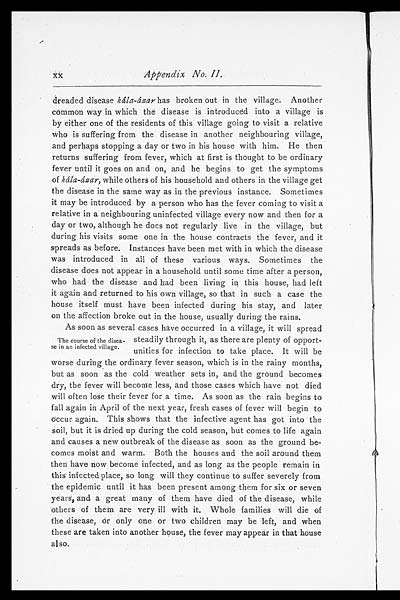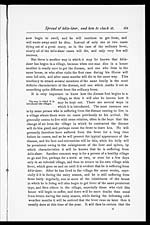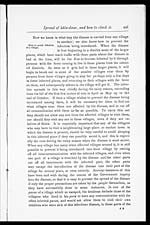Medicine - Institutions > Army health reports and medical documents > Report of an investigation of the epidemic of malarial fever in Assam, or, kala-azar > Appendix No. 2 - On the spread of kala-azar, and how to check it
(274) Page xx
Download files
Individual page:
Thumbnail gallery: Grid view | List view

xx
Appendix No. II.
dreaded disease kála-ázar has broken out in the village. Another
common way in which the disease is introduced into a village is
by either one of the residents of this village going to visit a relative
who is suffering from the disease in another neighbouring village,
and perhaps stopping a day or two in his house with him. He then
returns suffering from fever, which at first is thought to be ordinary
fever until it goes on and on, and he begins to get the symptoms
of kála-ázar, while others of his household and others in the village get
the disease in the same way as in the previous instance. Sometimes
it may be introduced by a person who has the fever coming to visit a
relative in a neighbouring uninfected village every now and then for a
day or two, although he does not regularly live in the village, but
during his visits some one in the house contracts the fever, and it
spreads as before. Instances have been met with in which the disease
was introduced in all of these various ways. Sometimes the
disease does not appear in a household until some time after a person,
who had the disease and had been living in this house, had left
it again and returned to his own village, so that in such a case the
house itself must have been infected during his stay, and later
on the affection broke out in the house, usually during the rains.
The course of the disea-
se in an infected village.
As soon as several cases have occurred in a village, it will spread
steadily through it, as there are plenty of opport-
unities for infection to take place. It will be
worse during the ordinary fever season, which is in the rainy months,
but as soon as the cold weather sets in, and the ground becomes
dry, the fever will become less, and those cases which have not died
will often lose their fever for a time. As soon as the rain begins to
fall again in April of the next year, fresh cases of fever will begin to
occur again. This shows that the infective agent has got into the
soil, but it is dried up during the cold season, but comes to life again
and causes a new outbreak of the disease as soon as the ground be-
comes moist and warm. Both the houses and the soil around them
then have now become infected, and as long as the people remain in
this infected place, so long will they continue to suffer severely from
the epidemic until it has been present among them for six or seven
years, and a great many of them have died of the disease, while
others of them are very ill with it. Whole families will die of
the disease, or only one or two children may be left, and when
these are taken into another house, the fever may appear in that house
also.
Set display mode to: Large image | Zoom image | Transcription
Images and transcriptions on this page, including medium image downloads, may be used under the Creative Commons Attribution 4.0 International Licence unless otherwise stated. ![]()
| Permanent URL | https://digital.nls.uk/75015122 |
|---|




